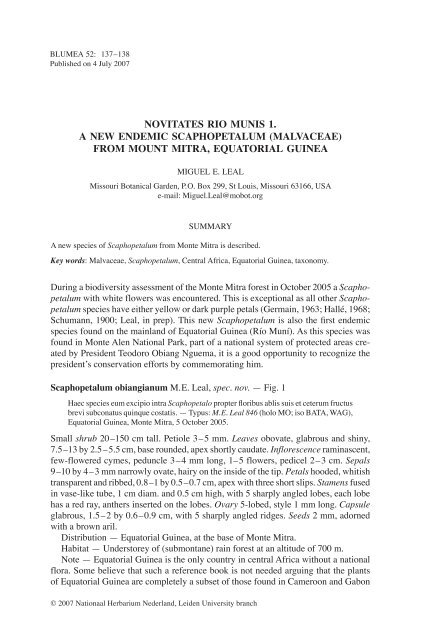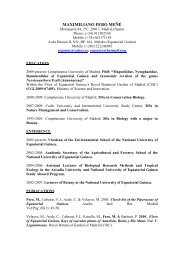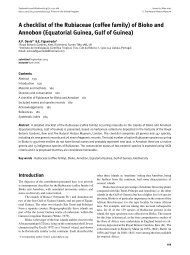novitates rio munis 1. a new endemic scaphopetalum - Flora de ...
novitates rio munis 1. a new endemic scaphopetalum - Flora de ...
novitates rio munis 1. a new endemic scaphopetalum - Flora de ...
You also want an ePaper? Increase the reach of your titles
YUMPU automatically turns print PDFs into web optimized ePapers that Google loves.
BLUMEA 52: 137–138<br />
Published on 4 July 2007<br />
NOVITATES RIO MUNIS <strong>1.</strong><br />
A NEW ENDEMIC SCAPHOPETALUM (MALVACEAE)<br />
FROM MOUNT MITRA, EQUATORIAL GUINEA<br />
MIGUEL E. LEAL<br />
Missouri Botanical Gar<strong>de</strong>n, P.O. Box 299, St Louis, Missouri 63166, USA<br />
e-mail: Miguel.Leal@mobot.org<br />
SUMMARY<br />
A <strong>new</strong> species of Scaphopetalum from Monte Mitra is <strong>de</strong>scribed.<br />
Key words: Malvaceae, Scaphopetalum, Central Africa, Equatorial Guinea, taxonomy.<br />
During a biodiversity assessment of the Monte Mitra forest in October 2005 a Scaphopetalum<br />
with white flowers was encountered. This is exceptional as all other Scaphopetalum<br />
species have either yellow or dark purple petals (Germain, 1963; Hallé, 1968;<br />
Schumann, 1900; Leal, in prep). This <strong>new</strong> Scaphopetalum is also the first <strong>en<strong>de</strong>mic</strong><br />
species found on the mainland of Equatorial Guinea (Río Muní). As this species was<br />
found in Monte Alen National Park, part of a national system of protected areas created<br />
by Presi<strong>de</strong>nt Teodoro Obiang Nguema, it is a good opportunity to recognize the<br />
presi<strong>de</strong>nt’s conservation efforts by commemorating him.<br />
Scaphopetalum obiangianum M.E. Leal, spec. nov. — Fig. 1<br />
Haec species eum excipio intra Scaphopetalo propter floribus ablis suis et ceterum fructus<br />
brevi subconatus quinque costatis. — Typus: M.E. Leal 846 (holo MO; iso BATA, WAG),<br />
Equatorial Guinea, Monte Mitra, 5 October 2005.<br />
Small shrub 20–150 cm tall. Petiole 3–5 mm. Leaves obovate, glabrous and shiny,<br />
7.5–13 by 2.5–5.5 cm, base roun<strong>de</strong>d, apex shortly caudate. Inflorescence raminascent,<br />
few-flowered cymes, peduncle 3–4 mm long, 1–5 flowers, pedicel 2–3 cm. Sepals<br />
9–10 by 4–3 mm narrowly ovate, hairy on the insi<strong>de</strong> of the tip. Petals hoo<strong>de</strong>d, whitish<br />
transparent and ribbed, 0.8–1 by 0.5–0.7 cm, apex with three short slips. Stamens fused<br />
in vase-like tube, 1 cm diam. and 0.5 cm high, with 5 sharply angled lobes, each lobe<br />
has a red ray, anthers inserted on the lobes. Ovary 5-lobed, style 1 mm long. Capsule<br />
glabrous, <strong>1.</strong>5–2 by 0.6–0.9 cm, with 5 sharply angled ridges. Seeds 2 mm, adorned<br />
with a brown aril.<br />
Distribution — Equatorial Guinea, at the base of Monte Mitra.<br />
Habitat — Un<strong>de</strong>rstorey of (submontane) rain forest at an altitu<strong>de</strong> of 700 m.<br />
Note — Equatorial Guinea is the only country in central Africa without a national<br />
flora. Some believe that such a reference book is not nee<strong>de</strong>d arguing that the plants<br />
of Equatorial Guinea are completely a subset of those found in Cameroon and Gabon<br />
© 2007 Nationaal Herbarium Ne<strong>de</strong>rland, Lei<strong>de</strong>n University branch
138<br />
BLUMEA — Vol. 52, No. 1, 2007<br />
Fig. <strong>1.</strong> Scaphopetalum obiangianum<br />
M.E. Leal. a. Habit; b. flower; c. capsule<br />
(a–c: Leal 846, MO, WAG).<br />
a<br />
b<br />
c<br />
and a<strong>de</strong>quately covered by the national floras of those countries. This <strong>new</strong> species<br />
from mainland Río Muní suggests that Equatorial Guinea’s flora may inclu<strong>de</strong> many<br />
<strong>en<strong>de</strong>mic</strong> contributions. The <strong>new</strong> find also <strong>de</strong>monstrates our poor knowledge of Equatorial<br />
Guinea’s flora and the need for more botanical field research.<br />
ACKNOWLEDGEMENTS<br />
Fieldwork was fun<strong>de</strong>d by the Central Africa Regional Program of the Environment (CARPE) in<br />
collaboration with Conservation International (CI) and Equatorial Guinea’s Instituto Nacional <strong>de</strong><br />
Desarrollo Forestal (INDEFOR).<br />
REFERENCES<br />
Germain, R. 1963. Sterculiaceae. Flore du Congo, du Rwanda et du Burundi 10: 212–219.<br />
Hallé, N. 1968. Sterculiaceae. Flore du Gabon 15: 115–125.<br />
Leal, M.E. In prep. A revision of the genus Scaphopetalum (Malvaceae).<br />
Schumann, K. 1900. Sterculiaceae africanae. In: A. Engler (ed.), Monogr. Afrik. Pflanzen-Fam. 6:<br />
90–92. Leipzig.






